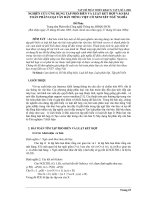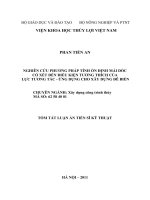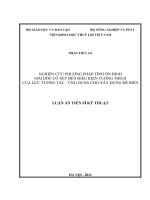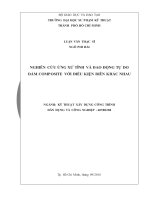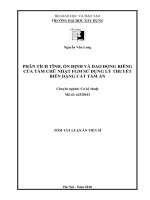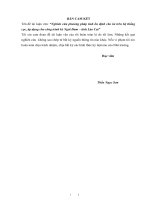NGHIÊN cứu ỨNG xử TĨNH, ổn ĐỊNH và DAO ĐỘNG dầm COMPOSITE với TIẾT DIỆN KHÁC NHAU tt tiếng anh
Bạn đang xem bản rút gọn của tài liệu. Xem và tải ngay bản đầy đủ của tài liệu tại đây (508.1 KB, 61 trang )
MINISTRY OF EDUCATION AND TRAINING
HO CHI MINH CITY
UNIVERSITY OF TECHNOLOGY AND EDUCATION
NGUYEN NGOC DUONG
VIBRATION, BUCKLING AND STATIC
ANALYSIS OF LAMINATED COMPOSITE
BEAMS WITH VARIOUS CROSS-SECTIONS
SUMMARY OF PhD. THESIS
MAJOR: ENGINEERING MECHANICS
No: 9520101
HCMC, December 2019
Declaration
I declare that this thesis is all my own work based on instruction
of my advisor.
The work contained in this thesis has not been submitted for any
other award.
Name: Ngoc-Duong Nguyen
Signature:
i
Abstract
Composite materials are widely used in many engineering fields
owing to their high stiffness-to-weight, strength-to-weight ratios, low
thermal expansion, enhanced fatigue life and good corrosive
resistance. Among them, laminated composite beams are popular in
application and attract a huge attention from reseacher to study the
their structural behaviours. Many theories are proposed for the
bending, buckling and vibration analysis. They can be divided into
classical beam theory (CBT), first-order beam theory (FOBT), higherorder beam theory (HOBT) and quasi-three dimension (quasi-3D)
beam theory. It should be noted that classical continuum mechanics
theories are just suitable for macro beams. For analysing microbeams,
researchers proposed many non-classical theories. Among them, the
modified couple stress theory (MCST) is the most popular and
commonly applied owing to its simplicity in formulation and
programming. In order to accurately predict behaviours of beams, a
large number of methods are developed. Numerical approaches are
used increasingly, however, analytical methods are also used by
researchers owing to their accuracy and efficiency. Among analytical
approaches, Ritz method is the most general one, which accounts for
various boundary conditions, however, it has seldom been used to
analyse the bending, buckling and free vibration behaviours of beams.
This is also the main motivation of this study.
This dissertation focuses on propsing new approximation
functions to analyse laminated composite beams with various crosssections and boundary conditions. The displacement field is based on
the FOBT, HOBT and quasi-3D theories. Size-dependent effect for
microbeams is investigated using the MCST. Poisson’s effect is
considered by integrating in the constitutive equations. The governing
equations of motion are derived from Lagrange’s equations.
Numerical results for beam with various boundary conditions are
presented and compared with existing ones available in the literature.
The effects of fiber angle, length-to-height ratio, material anisotropy,
ii
shear and normal strains on the displacements, stresses, natural
frequencies, mode shape and buckling loads of the composite beams
are investigated. Some of numerical results are presented at the first
time and can be used as the benchmark results for numerical methods.
Besides, a study on efficacy of approximation functions for analysis
of laminated composite beams with simply-supported boundary
conditions is carried out.
iii
List of Publications
ISI papers with peer-reviews:
1. N.-D. Nguyen, T.-K. Nguyen, T.P. Vo, T.-N. Nguyen, and S.
Lee, Vibration and buckling behaviours of thin-walled composite and
functionally graded sandwich I-beams, Composites Part B:
Engineering. 166 (2019) 414-427.
2. N.-D. Nguyen, T.-K. Nguyen, T.P. Vo, and H.-T. Thai, Ritzbased analytical solutions for bending, buckling and vibration
behavior of laminated composite beams, International Journal of
Structural Stability and Dynamics. 18(11) (2018) 1850130.
3. N.-D. Nguyen, T.-K. Nguyen, T.P. Vo, and H.-T. Thai, A Ritz
type solution with exponential trial functions for laminated composite
beams based on the modified couple stress theory, Composite
Structures. 191 (2018) 154-167.
4. N.-D. Nguyen, T.-K. Nguyen, T.-N. Nguyen, and H.-T. Thai,
New Ritz-solution shape functions for analysis of thermo-mechanical
buckling and vibration of laminated composite beams, Composite
Structures. 184 (2018) 452-460.
5. T.-K. Nguyen, N.-D. Nguyen, T.P. Vo, and H.-T. Thai,
Trigonometric-series solution for analysis of laminated composite
beams, Composite Structures. 160 (2017) 142-151.
Domestic papers with peer-reviews:
6. T.-K. Nguyen and N.-D. Nguyen, Effects of transverse normal
strain on bending of laminated composite beams, Vietnam Journal of
Mechanics. 40(3) (2018) 217-232.
7. X.-H. Dang, N.-D. Nguyen, T.-K. Nguyen, Dynamic analysis
of composite beams resting on winkler foundation, Vietnam Journal
of Construction (8-2017) 123-129.
8. N.-D. Nguyen, T.-K. Nguyen, T.-N. Nguyen, Ritz solution for
buckling analysis of thin-walled composite channel beams based on a
classical beam theory, Journal of Science and Technology in Civil
Engineering (STCE)-NUCE. 13(3) (2019) 34-44
iv
Conference papers:
9. N.-D. Nguyen, T.-K. Nguyen, T.-N. Nguyen, and T.P. Vo,
Bending Analysis of Laminated Composite Beams Using Hybrid
Shape Functions, International Conference on Advances in
Computational Mechanics. (2017), (503-517).
10. N.-D. Nguyen, T.-K. Nguyen, Free vibration analysis of
laminated composite beams based on higher – order shear deformation
theory. Proceeding of National Confrence-Composite Material and
Structure (2016) 157-164.
11. N.-D. Nguyen, T.-K. Nguyen, and T.P. Vo, Hybrid-shapefunctions for free vibration analysis of thin-walled laminated
composite I-beams with different boundary conditions, Proceeding of
National Mechanical Confrence (2017) 424-433
v
Table of content
Declaration.................................................................................................... i
Abstract ........................................................................................................ ii
List of Publications ..................................................................................... iv
Table of content .......................................................................................... vi
List of Figures ........................................................................................... viii
List of Tables ............................................................................................ viii
Nomenclature .............................................................................................. ix
Abbreviations ............................................................................................. xii
Chapter 1. INTRODUCTION...................................................................... 1
1.1. Composite material ........................................................................... 1
1.1.1. Fiber and matrix ......................................................................... 1
1.1.2. Lamina and laminate .................................................................. 1
1.1.3. Applications ............................................................................... 1
1.2. Overview........................................................................................... 1
1.2.1. Literature review ........................................................................ 1
1.2.2. Objectives of the thesis .............................................................. 4
1.3. Organization ..................................................................................... 5
Chapter 2. ANALYSIS OF LAMINATED COMPOSITE BEAMS BASED
ON A HIGH-ORDER BEAM THEORY .................................................... 6
2.1. Introduction....................................................................................... 6
2.2. Beam model based on the HOBT ..................................................... 7
2.2.1. Kinetic, strain and stress relations ............................................. 7
2.2.2. Variational formulation.............................................................. 7
2.3. Numerical examples ........................................................................ 9
2.4. Conclusion ........................................................................................ 9
vi
Chapter 3. VIBRATION AND BUCKLING ANALYSIS OF LAMINATED
COMPOSITE BEAMS UNDER THERMO-MECHANICAL LOAD ..... 10
3.1. Introduction..................................................................................... 10
3.2. Theoretical formulation .................................................................. 11
3.2.1. Beam model based on the HOBT ............................................ 11
3.2.2. Solution procedure ................................................................... 12
3.3. Numerical results ............................................................................ 13
3.4. Conclusions..................................................................................... 13
Chapter 4. EFFECT OF TRANSVERSE NORMAL STRAIN ON
BEHAVIOURS OF LAMINATED COMPOSITE BEAMS .................... 14
4.1. Introduction..................................................................................... 14
4.2. Theoretical formulation .................................................................. 15
4.2.1. Kinetic, strain and stress relations ........................................... 15
4.2.2. Variational formulation............................................................ 15
4.3. Numerical results ........................................................................... 16
4.4. Conclusions..................................................................................... 17
Chapter 5. SIZE DEPENDENT BEHAVIOURS OF MICRO GENERAL
LAMINATED COMPOSITE BEAMS BASED ON MODIFIED COUPLE
STRESS THEORY .................................................................................... 18
5.1. Introduction..................................................................................... 18
5.2. Theoretical formulation .................................................................. 20
5.2.1. Kinematics ............................................................................... 20
5.2.2. Constitutive relations ............................................................... 20
5.2.3. Variational formulation............................................................ 21
5.2.4. Ritz solution ............................................................................. 21
5.3. Numerical results ........................................................................... 21
vii
5.4. Conclusions..................................................................................... 22
Chapter 6. ANALYSIS OF THIN-WALLED LAMINATED COMPOSITE
BEAMS BASED ON FIRST-ORDER BEAM THEORY ........................ 23
6.1. Introduction..................................................................................... 23
6.2. Theoretical formulation .................................................................. 25
6.2.1. Kinematics ............................................................................... 25
6.2.2. Constitutive relations ............................................................... 25
6.2.3. Variational formulation............................................................ 26
6.2.4. Ritz solution ............................................................................. 26
6.3. Numerical results ........................................................................... 27
6.4. Conclusions..................................................................................... 28
Chapter 7. CONVERGENCY, ACCURARY AND NUMERICAL
STABILITY OF RITZ METHOD............................................................. 28
7.1. Introduction..................................................................................... 28
7.2. Results of comparative study and conclusions ............................... 29
Chapter 8. CONCLUSIONS AND RECOMMENDATIONS................... 29
8.1. Conclusions..................................................................................... 29
8.2. Recommendations........................................................................... 30
References.................................................................................................. 30
List of Figures
Figure 2.1. Geometry and coordinate of a laminated composite
beam. .................................................................................................. 7
List of Tables
Table 2.1. Approximation functions of the beams. ............................. 8
Table 2.2. Kinematic BCs of the beams. ............................................ 8
viii
Table 2.3. Normalized mid-span displacements of (00/900/00)
composite beam (MAT II.2, E1/E2 = 25). ........................................... 9
Table 3.1. Approximation functions and kinematic BC of the beams.
.......................................................................................................... 12
Table 3.2. The fundamental frequency (Hz) of (00/900/00) and
(00/900) beams with various boundary conditions (MAT II.3). ........ 13
Table 4.1. Approximation functions and kinematic BCs of beams. . 16
Table 4.2. Nondimensional stresses of (00/900/00) and (00/900)
composite beams with S-S boundary condition under a uniformly
distributed load (MAT II.4). ............................................................. 17
Table 5.1. Approximation functions and essential BCs of beams .... 21
Table 5.2. Displacement of S-S beams (MAT II.5)........................... 22
Table 6.1. Approximation functions and essential BCs of thin-walled
beams. .............................................................................................. 27
Table 6.2. The fundamental frequency (Hz) of thin-walled S-S and CF I-beams ......................................................................................... 27
Nomenclature
b, h, L:
Width, height and length of rectangular beam
b1 , b2 , b3 :
Top flange width, bottom flange width and web of Isection or channel section
h1 , h2 , h3 :
Thichness of top flange, bottom flange and web of Isection or channel section
u0 :
Axial displacement
w0 :
Transverse (vertical) displacement
u1 :
Rotation of a transverse normal about the y axis
ix
w1 , w2 :
f ( z) :
u, v, w:
u , v , w:
Additional higher-order terms
Shear variation function
Displacement components in x, y and z directions
Mid-surface displacement components in x, y and z
directions of thin-walled beam
t:
Time
E or E n : Young’s modulus
E1 , E2 , E3 : Young’s modulus in the fibre and transverse directions
G12 , G13 , G23 :
Shear moduli
, 12 , 13 , 23 :
Poisson’s coefficient
Material parameter
p:
1 , 2 :
Thickness ratio of ceramic material of the top and
bottom flange
Thermal coefficients in local coordinate
1* , 2* :
x , y , xy : Thermal coefficients in global coordinate
:
Thickness ratio of ceramic material of the web
:
Mass density
c and m : Mass density of ceramic and metal
Vc :
Volume fraction of ceramic material
Cij :
Material stiffness coefficients in local coordinate
Cij :
Transformed material stiffness coefficients in global
coordinate
Cij or Cij* :
Reduced material stiffness coefficients in global
coordinate
ij or ij :
Strain
ij :
Stress
x
Qij :
Plan stress-reduced stiffness coefficients in local
coordinate
Qij :
Plan stress-reduced stiffness coefficients in global
coordinate
E :
Strain energy
W :
Work done
K :
:
j, j , j :
K:
M:
F:
x , y , z :
Kinetic energy
Total energy
Approximation functions
xy , zy :
Curvature fields
mxy , mzy :
Stress-curvature
Stiffness matrix
Mass matrix
Load Vecter
Rotation about the x -, y -, z -axes
kb b , km1 , km 2 : The MLSPs in x , -, y, - and z -directions
U,V ,W:
direction
:
Displacement of shear center (P) in the x , y , z
Rotation angle about pole axis
s :
Angle of orientation between ( n, s , x ) and ( x, y, z )
coordinate systems
y , z , : Rotations of the cross-section with respect to y , z ,
:
Iy , Iz :
Wapping function
Second moment of inertia with respect y , z axis
IP :
centroid
ks :
:
Polar moment of inertia of the cross-section about the
Shear correction factor
Natural frequency
xi
Ncr :
Critical buckling load
N0 , N x0 m :
Axial mechanical load
0t
x
N :
Axial thermal load
Uniformly distributed load
q:
Abbreviations
BCs:
Boundary condition(s)
C-F:
Clamped-free
C-S:
Clamped-simply supported
C-H:
Clamped-hinged
C-C:
Clamped-clamped
CUF:
Carrera’s unified formulation
CBT:
Classical beam theory
DQM: Differential quadrature method
ESLT: Equivalent single layer theory
FOBT:
First-order beam theory
FEM:
Finite element method
HOBT:
Higher-order beam theory
H-H:
Hinged-hinged
LWT:
Layer-wise theory
MAT:
Material
MCST:
Modified Couple Stress Theory
MLSP:
Material Length Scale Parameter
MGLCB:
Micro general laminated composite beam
Quasi-3D:
Quasi-three dimension beam theory
S-S:
Simply-supported
ZZT:
Zig-zag theory
xii
Chapter 1. INTRODUCTION
1.1. Composite material
1.1.1. Fiber and matrix
A composite material, which is combined of two or more
materials, leads to improve properties such as stiffness, strength,
weight reduction, corrosion resistance, thermal properties...than those
of the individual components used alone. It is made from a
reinforcement as fiber and a base as matrix, is divided into commonly
three different types [1]
(1) Fibrous materials: fibers of one material and matrix of another one
(2) Particulate composites: macro size particles of one material and
matrix of another one
(3) Laminate composites: made of several layers of different
materials, including of the first two types.
1.1.2. Lamina and laminate
A fiber-reinforced lamina consists of many fiber embedded in a
matrix material. The fiber can be continuous or discontinuous, woven,
unidirectional, bidirectional or randomly distributed.
A laminate is a collection of lamina with various orientations
stacked to achieve the desired stiffness and thickness. The layers are
usually bonded together with the same matrix material as that in a
lamina. The stiffness and strength of the laminate can be tailored to
meet requirements by selecting the lamination scheme and material
properties of individual lamina.
1.1.3. Applications
In recent years, composite materials are widely used in many
fields of civil, aeronautical and mechanical engineering. The most
well-known advantages of these materials are high stiffness-to-weight
and strength-to-weight ratios, low thermal expansion, enhanced
fatigue life and good corrosive resistance.
1.2. Overview
1.2.1. Literature review
1
In order to use composite materials in practice, the available
literatures indicate that a large number of studies have been conducted
to analyse their structural responses. Beam theories, constitutive laws
and methods are proposed in order to predict vibration, buckling and
bending behaviours of beams. In this section, a bief review study for
laminated composite beams is presented. More review details for
specific topic are available in the beginning of each chapter.
For composite beam models, a literature review on the composite
beam theories can be seen in the previous works of Ghugal and Shimpi
[2]. Based on equivalent single layer theories, beam theories can be
divided into main categories: classical beam theory, first order beam
theory, higher-order beam theory and quasi-3D beam theory. The
classical beam theory neglects transverse shear strain effects, and
therefore it is only suitable for thin beams. The first order shear
deformation theory accounts for the transverse shear strain effect,
however it requires a shear correction factor. The higher-order beam
theory is proposed by using distribution functions of transverse shear
stresses. However, this theory ignores transverse normal strain effect,
and therefore quasi-3D beam theory is presented. It can be seen that
the accuracy of beam responses depends on the choices of appropriate
theories, and quasi-3D beam theory is the most general one. The
review work of Ghugal and Shimpi [2] also indicates that Poisson’s
effect on behaviours of laminated composite beams is not paid much
attention. Moreover, when the behaviours of structures are considered
at a small scale, the experimental studies showed that the size effect is
significant to be accounted, that led to the development of Eringen’s
nonlocal elasticity theory [3] and strain gradient theory [4-6]. Based
on this approach, many studies are investigated and applied for
analysis of composite microbeam [7-13]. The available literature
indicate that studies mainly focus on cross-ply microbeams.
Therefore, the study of micro general laminated composite beams with
arbitrary lay-ups is necessary.
2
Furthermore, composite materials are applied for thin-walled
structures with different sections, many studies are developed based
on the thin-walled structures theory. Vlasov [14] proposed a thinwalled structure theory for isotropic materials. Bauld and Tzeng [15]
expanded Vlasov’s theory for buckling analysis of laminated
composite thin-walled rods. Song and Librescu [16] investigated
dynamic responses of laminated composite beams with arbitrary
sections. Lee and Kim [17, 18] presented a general model to predict
vibration and buckling responses of laminated composite thin-walled
beams with I-sections by classical beam theory. It is clear that shear
deformation effects on behaviours of thin-walled composite beams is
still limited.
For computational methods, many computational methods have
been developed in order to predict accurately responses of composite
structures, namely, analytical, numerical and semi-numerical. The
nature of these methods has been either exact or approximate. For
numerical method, finite element method (FEM) is the most widely
used numerical method for the free vibration, buckling and bending
analysis of composite beams [19-28]. In addition, finite difference
method [29, 30], Chebyshev collocation technique [31], dynamic
stiffness matrix method [32] are also used to predict behaviours of
beams. In recent year, isogeometric analysis [33, 34] attracted an
interest of many researchers. This thesis will focus more details on
analytical solutions. Among them, Navier procedure can be seen as
the simplest one. Although this method is only suitable for simply
supported boundary condition, it has widespread used by many
authors owing to its simplicity [35, 36]. Other analytical approaches
have been investigated for analysis of composite beams, including
differential quadrature method (DQM) [37, 38], Galerkin method [3941] or differential transform method [42, 43]. The Ritz method, which
mainly uses in this thesis, is the most general one which accounts for
various boundary conditions. It is a variational approach in which the
shape functions are chosen to approximate the unknown displacement
3
fields. The displacement functions should be complete in the function
space, and inappropriate choices of the unknown functions may cause
numerical instabilities and slow convergence rates. The available
literatures indicated that polynomial and orthogonal polynomial
functions are used commonly for laminated composite beams. The
polynomial functions usually do not satisfy the boundary conditions.
Therefore, the penalty method or langrage multiplier method is used
to compose the boundary conditions [44, 45]. This leads to an increase
in the dimension of the stiffness and mass matrices and thus causes
computational costs. The orthogonal polynomial functions overcome
this drawback by satisfying the specific boundary conditions [46-48].
However, these functions have seldom been used to analyse bending
behaviour of laminated composite beams. Therefore, it can be seen
that there is a need for further studies about Ritz method for beam
problems.
In Vietnam, the behaviour analysis of composite structures have
attracted a number of researches. Nguyen-Xuan et al. [49-52], Nguyen
et al. [53-55] analyse behaviours of composite plate. These studies
focus on the development of advanced numerical methods such as the
FEM, mesh-less method, isogeometry method and optimization
theory of structures. Nguyen et al. [56-59] developed analytical
methods for analysis of composite plates and shells with various
geometric shapes and loading conditions. Tran et al. [60, 61] carried
out some experimental studies on composite structures. Hoang et al.
[62, 63] studied responses of functionally graded plates and shells
under thermo-mechanical loads. Nguyen et al. [64, 65] investigated
behaviors of functionally graded beams by the FEM under some
different geometric and loading conditions. It is interesting that
researchers in Vietnam have not paid much attention to laminated
composite beam problems, especially composite thin-walled beams
yet.
1.2.2. Objectives of the thesis
4
The literature review on the behaviours of composite beams shows
that Ritz method is efficient to analyse the behaviours of composite
beams with various boundary conditions, however, the number of
researches used this method is still limited. Therefore, developing the
simple, effective and accurate approximation functions to solve
structural behaviours of composite beams with various cross-sections
is one of the primary motivations of this study. In addition, the
available literature indicate that effects of Poisson ratio, normal strain,
size dependent on behaviours of composite beams are not wellinvestigated. The main contents of this thesis include:
- Analyse free vibration, buckling and static of laminated composite
beams using HOBT.
- Analyse free vibration, buckling and static of laminated composite
beams using quasi-3D theory.
- Analyse free vibration, buckling and static of general micro
laminated composite beams using modified couple stress theory.
- Analyse free vibration, buckling and static of thin-walled laminated
composite beams using FOBT.
- Appraise and select approximation functions for analysis of
laminated composite beams.
1.3. Organization
There are eight chapters in this thesis. Chapter One describes the
purpose, scope and organization as well as the review study on
laminated composite beams. Based on the HOBT, Chapter Two deals
with the buckling, bending and free vibration behaviours of laminated
composite beam. In this Chapter, new trigonometric functions are
proposed. The theoretical formulation in Chapter Two is extended in
Chapter Three. Effect of mechanical and thermal load on buckling and
free vibration behaviours of composite beams are considered. New
hybrid functions are proposed. Chapter Four focuses on the effects of
normal strain and Poisson’s ratio on buckling, bending and free
vibration behaviours of beams. Both HOBT and quasi-3D theories are
used to investigate effects of normal strain and Poisson’s ratio. The
5
modified couple stress theory is employed in Chapter Five for microlaminated composite beams using HOBT and the exponential
functions are proposed to solve problem. Poisson’s effect on buckling,
bending and free vibration behaviours of general micro-laminated
composite beams is investigated. Chapter Six analyses thin-walled
laminated composite and functionally graded thin-walled beams based
on FOBT. Numerical results about frequency, critical buckling load
and displacement of channel and I-beams are presented. Study on new
approximation functions is carried in Chapter Seven. Convergence,
computational cost and numerical stability are investigated to verify
efficiency of proposed functions. In the last Chapter, the main
conclusions and recommendations for future research are presented.
Chapter 2. ANALYSIS OF LAMINATED COMPOSITE
BEAMS BASED ON A HIGH-ORDER BEAM THEORY
2.1. Introduction
A general review and assessment of these theories for composite
beams can be found in [2, 66-68]. It should be noted that HOBT has
been increasingly applied in predicting responses of composite beams.
For numerical methods, finite element method has been widely
used to analyse composite beams [20-27, 69-71]. For analytical
approach, Navier solution is the simplest one [35, 36, 72, 73]. In order
to deal with arbitrary boundary conditions, many researchers
developed different methods. Ritz-type method is commonly used
[44, 47, 48, 74]. Khdeir and Reddy [75, 76] developed state-space
approach to derive exact solutions for the natural frequencies and
critical buckling loads of cross-ply composite beams. Chen et al. [77]
also proposed an analytical solution based on state-space differential
quadrature for vibration of composite beams. By using the dynamic
stiffness matrix method, Jun et al. [32, 78] calculated the natural
frequencies of composite beams based on third-order beam theory. A
literature review shows that although Ritz procedure is efficient to
deal with static, buckling and vibration problems of composite beams
with various boundary conditions, the research on this interesting
6
topic is still limited. The objectives of this Chapter is to develop a new
trigonometric-series solution for analysis of composite beams.
2.2. Beam model based on the HOBT
A laminated composite beam with rectangular section (bxh) and
length L as shown in Fig. 2.1 is considered. It is made of n plies of
orthotropic materials in different fibre angles with respect to the xaxis.
Figure 2.1. Geometry and coordinate of a laminated composite
beam.
2.2.1. Kinetic, strain and stress relations
In this Chapter, the displacement field of composite beams is
based on the HOBT [79, 80] as:
w ( x , t ) 5 z 5 z 3
(2.1)
u ( x , z , t ) u0 ( x , t ) z 0
2 u1 ( x, t )
x
4 3h
w( x, z, t ) w0 ( x, t )
The elastic strain and stress relations:
(k )
Q11 0
x
0
Q
xz
55
2.2.2. Variational formulation
7
(k )
(2.2)
x
xz
(2.3)
1
x x xz xz dV
2 V
L
L
1
The work done W : W qw0bdx N 0 ( w0, x )2 bdx
20
0
The strain energy E :
(2.4)
E
The kinetic energy K : K
1
z u
2
w
2
2V
(2.5)
dV
(2.6)
E W K
The total energy :
In this Chapter, Ritz solution is used:
m
m
(2.7)
m
u0 (x, t) j (x)u0 jeit , w0 (x, t) j (x)w0 jeit , u1(x, t) j (x)u1 jeit
j 1
j 1
(2.8)
j 1
where is the frequency, i 2 1 the imaginary unit; u0j , w0j , u1 j are
values to be determined; j ( x) ,
j ( x) ,
approximation functions (see Table 2.1).
Table 2.1. Approximation functions of the beams.
j ( x)
j ( x)
BC
j x
j x
cos
sin
L
L
(2 j 1) x
(2 j 1) x
C-F sin
1 cos
2L
2L
2 j x
j x
sin
sin 2
C-C
L
L
Table 2.2. Kinematic BCs of the beams.
BC
Position
Value
w0 0
S-S
x=0
S-S
C-F
and
j ( x ) are
j ( x)
j x
cos
L
(2 j 1) x
sin
2L
2 j x
sin
L
x=L
w0 0
x=0
x=L
u0 0 , w0 0 , w0, x 0 , u1 0
8
BC
C-C
Position
x=0
Value
u0 0 , w0 0 , w0, x 0 , u1 0
u0 0 , w0 0 , w0, x 0 , u1 0
x=L
The governing equations are obtained from Lagrange’s equations:
(2.9)
K 2M u F
2.3. Numerical examples 1
Numerical results have been published in Composite Structures in
2017. In this section, author just show a typical example for your
reference. Table 2.3 displays normalized mid-span displacements of
(00/900/00) composite beam under a uniformly distributed load. It can
be seen that the present result is agreement with those of available
literature.
Table 2.3. Normalized mid-span displacements of (00/900/00)
composite beam (MAT II.2, E1/E2 = 25).
BC Theory
L/h
5
10
50
S-S Present
2.412
1.096
0.665
Khdeir and Reddy [81]
2.412
1.096
0.665
Vo and Thai (HOBT) [22]
2.414
1.098
0.666
C-F Present
6.813
3.447
2.250
Khdeir and Reddy [81]
6.824
3.455
2.251
Vo and Thai (HOBT) [22]
6.830
3.461
2.257
C-C Present
1.536
0.531
0.147
Khdeir and Reddy [81]
1.537
0.532
0.147
2.4. Conclusion
The new analytical solution is proposed for static, buckling and
vibration analysis of laminated composite beams based on a HOBT.
The obtained results show that:
- Beam model is suitable for free vibration, buckling and bending
analysis of laminated composite beams.
1
Numerical results have been published in Composite Structures in 2017 [123]
9
- The proposed series solution converges quickly for buckling
analysis.
- The present solution is found to simple and efficient in analysis of
laminated composite beams with various boundary conditions.
Chapter 3. VIBRATION AND BUCKLING ANALYSIS OF
LAMINATED COMPOSITE BEAMS UNDER THERMOMECHANICAL LOAD
3.1. Introduction
The laminated composite beam has been widely used in multiphysics environments such as construction, transportation, nuclear,
etc. Among numerical approaches, finite element method is the most
popular one used for the analysis of laminated composite beams.
Mathew et al. [82] investigated the thermal buckling behaviour of
composite beams, whilst Lee [83] examined the thermal buckling
response of composite beams based on a layerwise theory. Murthy et
al. [24] and Vo and Thai [22] used a higher-order shear deformation
beam theory to predict the bending behaviour of laminated composite
beams. Vo and Thai [21] also applied the HOBT to analyse the
mechanical buckling and vibration of laminated composite beams. For
analytical approaches, Kant et al. [84] studied the dynamic responses
of laminated composite beams based on Navier solution procedure.
Emam and Eltaher [85] investigated buckling and postbuckling
behaviours of laminated composite beams in hygrothermal
environment. Khdeir and Reddy ([76], [86]) used a state-space
approach for buckling analysis of cross-ply laminated composite
beams. The thermal buckling behaviour of laminated composite
beams was also investigated by Khdeir [87]. Moreover, Abramovich
[88] predicted thermal buckling load of laminated composite beams
based on an analytical solution. Based on Ritz method and the HOBT,
Aydogdu examined the free vibration [74], mechanical buckling [48]
and thermal buckling [89] of laminated composite beams with
different boundary conditions. Wattanasakulpong et al. [90] used
polynomial functions to determine thermal buckling load and free
10
vibration of functionally graded beams. Mantari and Canales [44] also
used Ritz method to predict mechanical buckling and vibration
responses of laminated composite beams. Asadi et al. [91] analysed
the nonlinear vibration and thermal stability laminated composite
beams based on Galerkin method. Warminska et al. [92] analysed the
vibration of composite beams under thermal and mechanical loadings
based on the FOBT. Jun et al. [93] applied dynamic stiffness method
to analyse the vibration and buckling of laminated composite beams.
Vosoughi et al. [94] adopted the differential quadrature method and
the FOBT to study the thermal buckling and postbuckling behaviours
of laminated composite beams with temperature-dependent
properties. It can be seen that Ritz method has not been widely used
to analyse laminated composite beams under thermal and mechanical
loadings. The objective of this Chapter is to develop a Ritz solution
for thermo-mechanical buckling and vibration of laminated composite
beams.
3.2. Theoretical formulation
A laminated composite beam, which is defined in Chapter Two
(Fig. 2.1), is supposed to be embedded in thermal environment with a
uniform temperature rise through the beam thickness as:
T T0 T
(3.1)
where T0 is reference temperature which is supposed to be one at the
bottom surface of the beam.
3.2.1. Beam model based on the HOBT
The displacement fields are based on the HOBT [79, 80] as in
Chapter Two.
The work done W :
L
L
1
1
W N x0 m ( w0, x )2 bdx N x0t ( w0, x )2 bdx
20
20
11
(3.2)
where N x0 m and N x0t are the axial mechanical load and axial thermal
stress resultant, respectively. For a temperature rise T T0 , the
thermal axial stress resultant is given by:
n zk 1
N x0t
Q
11
x
Q12 y Q16 xy T T0 dz
(3.3)
k 1 zk
The total energy of beams is obtained as:
E W K
(3.4)
3.2.2. Solution procedure
m
m
m
u0 (x, t) j (x)u0 jeit , w0 (x, t) j (x)w0 jeit , u1(x, t) j (x)u1 jeit (3.5)
j 1
j 1
j 1
j ( x) , j ( x ) and j ( x ) are approximation functions. This Chapter
proposed new hybrid approximation functions reported in Table 3.1.
Table 3.1. Approximation functions and kinematic BC of the beams.
j ( x)
j ( x)
j ( x)
BC Position
Value
jx / L
jx / L
jx / L
S-S
x=0
e
( L 2 x)
e
x( L x)
e
( L 2 x)
w0 0
x=L
H-H
x=0
x( L x)
x( L x)
1
x=0
u0 0 , w0 0
u0 0 , w0 0
x=L
C-F
w0 0
x
x2
x
x
x 2 ( L x)
x
u0 0 , w0 0 ,
w0, x 0 , u1 0
x=L
C-S
x=0
x=0
w0, x 0 , u1 0
w0 0
x=L
C-H
u0 0 , w0 0 ,
x( L x)
x 2 ( L x)
12
x
u0 0 , w0 0 ,
w0, x 0 , u1 0

